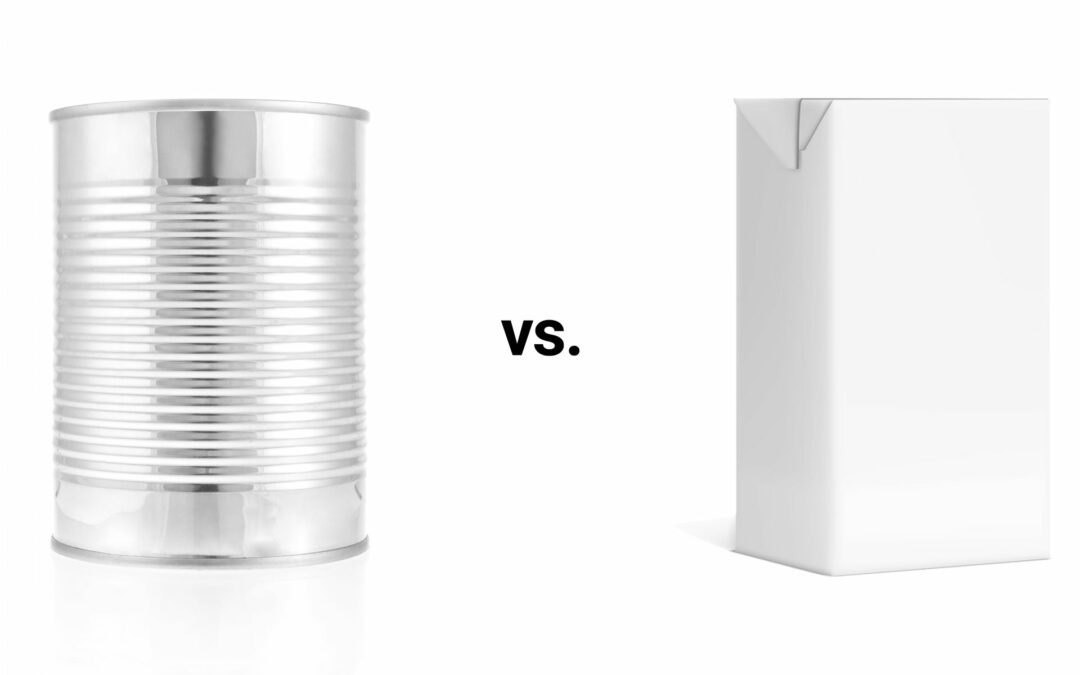I often get asked what materials make for the most sustainable packaging. The answer is somewhat nuanced. There are some key factors, such as whether the packaging is widely recycled in your market, but in practical terms the right answer tends to be specific to your product and priorities.
When specifying a solution, I like to understand what you are filling, how are you filling it, what shelf life do you need, and how will it be stored. To help bring this to life and give you some ideas when it comes to choosing your packaging, I thought I’d compare some of the different packaging options, explaining the pros and cons of each. In this article I’ll look at cans versus cartons for the packaging of retorted food for ambient sale – cooked beans, tomatoes and pulses, for example. So, which is better, can or carton?
Taking a holistic view
Choosing the right packaging involves taking a holistic view of the product. We need to consider not just the product and its packaging but how it’s produced and delivered. Of course, we also need to think about what happens after the consumer has finished with it too.
Inputs vs outputs
When we think about sustainability, we need to think about the inputs as well as the outputs. By that I mean considering the impact of producing the packaging to the result of recycling or disposing of it. For example, is it better to use packaging whose production process has a relatively low carbon footprint but has low levels of recyclability such as flexible plastic? Or should you look for packaging that is highly recyclable even if it requires more energy and emissions to create it such as glass. We need to think of the complete lifecycle of our packaging.
Tin plated steel food cans
Many food cans are most often made from sheets of steel that are formed and welded to make cans. They usually have coatings inside and out and may have a paper label or be printed. They’re made using a long-established process that offers some flexibility in terms of size at a reasonable cost. They are robust which helps during shipping and storage, as well as being reliable in terms of shelf-life. What’s more they are retortable – they can be heated with food inside to cook the product.
Steel food cans are infinitely recyclable with no loss of strength or quality. The recycling process is reasonably straightforward – any coatings, labels or even food residue are burnt off by the heat required to melt the steel. Steel food cans are widely recycled with excellent infrastructure and good consumer understanding. In fact, globally, steel is the most recycled packaging material.
Multilayer cartons
This widely used packaging option is made from about 80% paper. They are fortified through the addition of layers of aluminium and plastic, bonded with adhesives. The layers are added to enhance the protective barrier to maintain the integrity and shelf life of the product inside.
Cartons are transported flat and ‘popped up’ when it’s time to fill them, resulting in a lower carbon footprint to transport compared to steel cans. They tend to be cuboid – rather than having a circular section – which means that they are more space efficient when stacked.
When we look at the lifecycle of a food carton, we see that the creation of the product involves a lower level of resource input, has a much smaller carbon footprint and generates lower emissions. However, recycling rates for cartons have room for improvement. Tetra Cartons are recycled kerbside from 65% of homes in the UK (a very commendable improvement from 20% in 2007). More than 90% of local authorities are accepting Cartons for recycling. Sources vary but the actual recycling rate of the cartons is estimated at between 21 and 51% which is less than ideal. When recycling is standardised in 2023, and communications standardised across the UK, recycling rates should improve which will drive the possibility of a better recycling infrastructure in the UK.
Comparison
|
|
Metal Food Can |
Retort Carton |
|
UK Recycling rate |
||
|
Carbon Footprint |
Higher than Tetra, numbers not easily available |
|
|
Shelf life |
The steel can technically offers a longer shelf life, but in practice, both can offer over a year. |
|
|
Food waste |
Both formats do well to minimise food waste as they deliver portion-controlled food (depending on the contents and use occasion). |
|
|
Reuse |
No |
No |
|
Re-purpose |
Insignificant |
Insignificant |
Conclusions
If your brands’ focus is on emissions and reduction of carbon footprint, cartons should be prioritised as their creation involves fewer emissions.
If you prioritise recycling and taking packaging out of landfill or energy recovery from waste, steel cans are the better option given the high recycling rate and infinitely recyclable nature.
Consider what the most sustainable packaging options for your product, brand and business are? Book a discovery call today.

